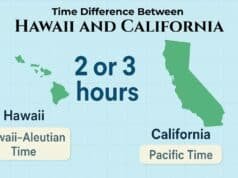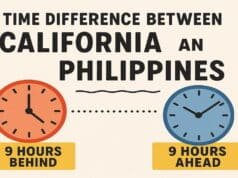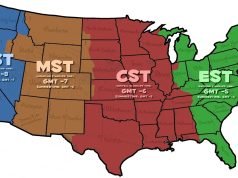The time in Colorado Time Zone is Mountain Standard Time (MST) during the day and Mountain Daylight Time (MDT) during the night.
Colorado observes Daylight Saving Time (DST), wherein the time is advanced by one hour to Mountain Daylight Time (MDT), which is six hours behind Greenwich Mean Time (GMT-6). After the summer months, Colorado reverts to US Mountain Standard Time (MST) or (GMT-7) by one hour.
What is The Time Zone of Colorado?
Colorado is located in the Mountain Time zone. There are no exceptions to the state’s uniform time zone for counties and cities. Due to daylight savings time in Colorado, two distinct clocks are depending on the season.
- Mountain Standard Time (MST): – 7:00 UTC/GMT (behind)
- Mountain Daylight Time (MDT): – 6:00 UTC/GMT (behind)
The significant majority of neighboring states (Utah, Wyoming, Arizona, New Mexico, and Nebraska) are in the same time zone. However, you will enter the Central Time Zone when you cross the northern and southern Kansas and Oklahoma borders.
The History of Colorado’s Time Zone
The time zone history of Colorado is a fascinating exploration into the evolution of timekeeping and its impact on the socio-economic development of the state. Nestled in the heart of the Rocky Mountains, Colorado’s time zone has played a crucial role in shaping its history and identity.
Early Days: Solar Time
Before the adoption of standard time zones, Colorado, like the rest of the world, relied on solar time. Each town set its clocks based on the position of the sun. This method, while straightforward, led to a lack of uniformity, causing confusion among railroads and travelers. Given Colorado’s geographical breadth, from plains to mountain peaks, the solar time varied significantly across different locations.
The Advent of Standard Time
The turning point came with the burgeoning railroad industry in the late 19th century. The need for a standardized time system became apparent as rail networks expanded and the inefficiency of multiple local times caused scheduling nightmares. In response, the U.S. railroads organized a convention to create a standardized time system.
On November 18, 1883, a day known as “The Day of Two Noons,” American railroads implemented a new system dividing the country into four standard time zones. Colorado was primarily placed in the Mountain Time Zone, which it still occupies today. This decision was crucial for synchronizing schedules and facilitating commerce and travel.
Legislative Actions
The Standard Time Act of 1918, also known as the Calder Act, legally established standard time zones within the U.S. This federal law was instrumental in formalizing the use of Mountain Standard Time (MST) in Colorado. The act also introduced Daylight Saving Time (DST), which has been subject to various adjustments and remains a topic of debate to this day.
The Impact of Time Zone on Colorado
The establishment of a uniform time zone in Colorado had profound implications. Economically, it streamlined transportation and commerce, particularly benefiting industries such as mining and agriculture, which were vital to Colorado’s economy. Socially, it brought a sense of unity and synchronization to the daily lives of Coloradans.
Daylight Saving Time Controversies
Colorado, like many other states, observes Daylight Saving Time, advancing clocks during the warmer months to extend evening daylight. However, the practice has been contentious, with debates about its health impacts, energy savings, and overall utility. Some communities in Colorado have debated opting out of DST, reflecting a broader national conversation about the relevance of this practice.
Current Considerations and Future Outlook
Today, Colorado remains in the Mountain Time Zone, sharing time with states like Wyoming, Utah, and parts of Arizona. As discussions about timekeeping continue, Colorado’s time policies may evolve. Proposals for year-round standard time or permanent daylight saving time reflect ongoing efforts to optimize time for the benefit of all Coloradans.
The history of Colorado’s time zone is more than a technical adjustment of clocks; it is a narrative of progress, unity, and adaptation, illustrating how time itself can be a pivotal factor in a region’s development. As time goes on, Colorado’s timekeeping will undoubtedly continue to adapt to the needs and well-being of its residents.
Colorado Time Zone Facts

Country | USA |
| Capital | Denver |
State | Colorado |
| Colorado Time Zone Name | Mountain Daylight Time |
Time Zone Abbreviation | MDT |
| Standard time zone | UTC/GMT -7 hours (Mountain Standard Time) |
Daylight saving time | +1 hour |
| The current time zone offset | UTC/GMT -6:00 hours (Mountain Daylight Time) |
Daylight Saving Time (DST) Start Date | Sunday 12 March 2023, 02:00 local standard time (MST) |
Daylight Saving Time (DST) Ends Date | Sunday 05 November 2023, 02:00 local daylight time (MDT) |
| Latitude | 39.73915 |
Longitude | -104.9847 |
Daylight Savings Time (DST) of Colorado
Colorado observes daylight saving time, as specified by the Uniform Time Act of 1966. Mountain Standard Time (MST) is replaced by Mountain Daylight Time (MDT) during daylight saving time. It begins on the second Sunday of March and ends on the first Sunday of November. In March, the clock is advanced from 2:00 a.m. to 3:00 a.m., resulting in a one-hour loss of sleep.
In November, the clocks will be turned back an hour, from 3:00 a.m. to 2:00 a.m., providing you with an extra hour of sleep. Clocks “spring forward and fall back” is an easy way to recall the movement sequence. The whole period of daylight savings is 34 weeks or around 65 percent of the year.
Why isn’t Colorado on Permanent Daylight Time Yet?
Legally, Colorado cannot adopt perpetual daylight time until the federal government gives its approval. This is because the federal law that initiated the program, the Uniform Time Act of 1966, only permits states to opt out of the program and does not permit them to opt in perpetually. A few states, including Colorado, have passed legislation that would make DST permanent once federal law is updated.
However, that is not the only factor preventing the state from experiencing later sunsets throughout the year. Even if Congress were to pass a law allowing states to observe DST year-round tomorrow, Colorado’s law requires at least four other states in the mountain time zone to enact similar legislation before it can take effect. Arizona, Montana, New Mexico, Utah, Wyoming, and the southern portion of Idaho are among these states.
Two states, Utah and Wyoming, enacted similar legislation before Colorado, leaving only two states to pass permanent DST legislation. This may, however, be simpler said than done. Idaho, for instance, is divided between two time zones. A proposal for 2020 would allow permanent DST in Idaho, but only in the northern half of the state and if Washington implemented a similar law.
Schedule a Phone Call from Texas to Colorado
You can call a friend in Colorado between 8:00 AM and 12:00 AM local time if you live in Texas. This will occur between 7 AM and 11 PM on their time, as Colorado is one hour behind Texas.
If you’re available at any time but want to contact someone at work in Colorado, attempt between 10:00 AM and 6:00 PM your time. During normal business hours, the best time to contact them is between 9 a.m. and 5 p.m.
| Texas | Colorado |
| 10:00 AM | 9:00 AM |
| 11:00 AM | 10:00 AM |
| 12:00 PM | 11:00 AM |
| 1:00 PM | 12:00 PM |
| 2:00 PM | 1:00 PM |
| 3:00 PM | 2:00 PM |
| 4:00 PM | 3:00 PM |
| 5:00 PM | 4:00 PM |
Frequently Asked Questions (FAQs)
What type of time zone is Colorado?
The current standard time in Colorado is the United States Mountain Standard Time (MST), except during daylight saving time (the second Sunday in March to the first Sunday in November) when time is advanced by one hour.
How does daylight savings work?
DST is often accomplished by advancing clocks by one hour in late winter or early spring (“spring forward”) and returning clocks by one hour in autumn (“fall back”) to revert to regular time. Consequently, there is one 23-hour day in the beginning of spring and one 25-hour day in the middle of autumn.
Is Colorado on CST or EST?
The current standard time in Colorado is the United States Mountain Standard Time (MST), except during daylight saving time (the second Sunday in March to the first Sunday in November) when time is advanced by one hour.
Is Colorado changing the time?
DENVER (KDVR) — Colorado will observe daylight time year-round beginning in June 2022, per legislation enacted by Governor Jared Polis. Nevertheless, the clocks fell back in November. In 2023, the clocks will once again be advanced an hour.
Is Colorado at the same time as Chicago?
Chicago is on Central time while Denver is on Mountain time.
What is Colorado known for?
Mountains, forests, canyons, and rivers all contribute to Colorado’s renowned natural splendor. It is without a doubt one of the most attractive states in the nation. With its towering mountains and pristine lakes, this location is ideal for outdoor enthusiasts.
Is Colorado always 2 hours behind New York?
No, Colorado is only two hours behind New York from the second Sunday in March until the first Sunday in November, during Daylight Saving Time (DST). Colorado observes Mountain Daylight Time (MDT), which is two hours behind Eastern Daylight Time (EDT) during DST.
Conclusion
In summary, the Colorado Time Zone is Mountain Standard Time (MST) and observes daylight saving time (DST). It is crucial to keep track of the time zone changes when traveling across state lines, especially for those visiting or residing in counties located in the southwest corner of the state.
By understanding the Colorado Time Zone changes during DST, travelers and residents can avoid any confusion about appointments or travel arrangements. Be sure to adjust your clocks accordingly when visiting or passing through Colorado to ensure that you are on schedule.















